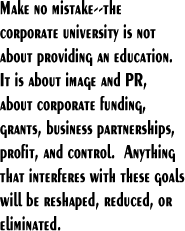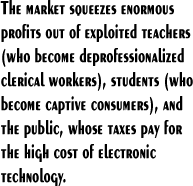1. Everyone who has been paying
attention knows that the
humanities, once the heart of the university,
have been devalued
in the United States. Thus, they are
often the first victims of
downsizing, tight budgets, or profit-driven
schemes. The
humanities can serve as a kind of mine canary:
when poison gas
builds up in academia, they are usually the
first to feel its
effects, but the other disciplines won't
be far behind. When the
humanities are handicapped and threatened
by the corporate
agenda, the whole academic endeavor as we
know it is at risk.
2. What academia is now facing the health
care industry has
already undergone. Physicians are under
pressure to make
diagnoses and recommend treatments on the
basis of profitability,
not medical need. Doctors are forced
into an assembly-line mode
and a speed-up. Decisions are made
by managers under orders from
the insurance companies that, increasingly,
own the hospitals and
facilities. Quality and choice have
declined as prices have
risen. Now there is talk of following
the HMO's with the
EMO--Education Maintenance Organizations.
And the privatization
of education is on the agenda of global trade
organizations (WTO,
FTAA, IMF, World Bank etc).
3. Education is being "redefined" around us,
but we are not
genuinely part of that process. On
the contrary, we are its
victims. Make no mistake--the corporate
university is not about
providing an education. It is about
image and PR, about
corporate funding, grants, business partnerships,
profit, and
control. Anything that interferes with
these goals will be
reshaped, reduced, or eliminated. Targeted
for elimination are
the rights of faculty to choose their own
teaching methodologies,
to set academic standards, and to control
the curriculum.
Students' choices will diminish and, in the
long run, tuition
will continue to rise. And freedom
of speech in the classroom
and in research will become an endangered
species. The redefined
university will have very little resemblance
to that interconnected community that has evolved over hundreds of years.
4. Faculty and students have common interests
and a common ground
on which to unite in the face of these threats.
Margaret Quan of
the California Part-Time Faculty Association
said it clearly:
"our working conditions are the students'
learning conditions."
An underpaid and overworked faculty that
sees its function
perverted and its discipline condemned as
useless, that is kept
busy and defensive jumping through senseless
bureaucratic hoops,
is not going to be able to focus on teaching
and serving the
academic community.
5. Corporate "redefinition" is also about
reallocation--the
redistribution of resources to predetermined
"growth areas." The
disciplines targeted for growth are not chosen
by the academic
community but by managers, consultants, and
outside investors.
Traditional programs not deemed profitable
are starved for
support, while the latest corporate fads
are promoted and
provided with funds for new positions, infrastructure,
and
publicity. It is generally the humanities--literature,
languages, philosophy, history--as well as
the visual arts and
basic sciences, that get the axe, for these
subjects are not high
on the scale of value in a society which
emphasizes size, speed,
and profitability.
6. Several events typically accompany the
move toward
corporatization. According to an AAUP
brochure on the corporate
model, "education is a commodity packaged
to fit customer demand,
priced to suit the market, and designed for
efficient delivery.
Corporate funding increasingly determines
the scope and direction
of academic research.... Scientific
discoveries and creative
works alike are judged in market terms."
7. As the corporate model takes hold, "pressure
mounts for
academe to conform to measurements that don't
assess quality.
Faculty careers are increasingly defined
by the rules of the
marketplace and by greater competition for
publicly supported
resources." The so-called "Blueprint
for the Future," a
far-reaching plan currently being promulgated
at UMKC, mandates
"a marked increase in overall faculty quality
as
demonstrated by
increased extramural funding (30-50% above
the current base
within the next six years)" (emphasis
added). But outside
funding opportunities are notoriously unequal
among various
fields, e.g. computer technology, business,
and the health
sciences as opposed to the humanities and
"unprofitable" types of
basic science. Thus the equating of
outside funding with
"faculty quality" is not only false, it is
also a formula for
punishing the humanities and a dangerous
move toward
privatization of the University.
8. The AAUP brochure goes on, the "exploitation
of contingent
labor fosters a production-line attitude
toward teaching...; the
content in core courses is made uniform so
that it can be
delivered more efficiently..." It is
also important to recognize
that the creation of an overworked and under-paid
contingent
teaching faculty lacking the protections
of job security and
academic freedom not only makes profits through
exploitation
but also has a political purpose, to bring
the faculty and its
functions more tightly under administrative
and corporate
control.
9. Finally, the AAUP brochure addresses the
question of distance
education, or the "virtual university," which
"defines teaching
as managing information .... [and] offer[s]
a watered-down
educational experience." Let me give
you an example of the
experience of one humanities department with
the combined forces
of the market and of an administration determined
to impose the
virtual model upon it.
10. Distance education used to mean the transmission
of courses
over many miles, serving a student audience
that can't take
regular courses on campus. In today's
practice, however,
distance education applies to both on- and
off-campus
instruction. It is merely the separation
of teacher and student,
the absence of face-to-face communication,
or the physical
absence of a teacher. Students can
take courses, for example, in
their dorm rooms or in computer labs.
This model exists not to
improve education or even convenience but
to create an education
market with a cheapened product. The
market squeezes enormous
profits out of exploited teachers (who become
deprofessionalized
clerical workers), students (who become captive
consumers), and
the public, whose taxes pay for the high
cost of electronic
technology. Quality control in instruction
is sacrificed to the
bottom line. The profits go to the
corporations who design and
sell the software, hardware, standardized
exams, updates, and so
on, and to a few well-placed administrators.
11. The failed experiment I am going to describe
took place in
the Language Resource Center at UMKC.
It fits the description of
distance education because it involved the
physical absence of a
teacher, and its purpose was to rake in profits
with a
substandard product and minimal labor costs.
Had it continued,
its long-term result would have been to hollow
out the Foreign
Language Department and turn it into an academic
Quik Trip. In
the place of professionals teaching the languages,
literatures,
and cultures of a dozen countries, we would
have become a row of
shrunken heads, the contents of our courses
sucked out, our
discipline reduced to rubble, and our students
blithely ignorant
of really existing foreign languages and
cultures.
12. UMKC College and Departmental rules state
that a course may
be given as an experimental offering a limited
number of times,
but then must either be withdrawn from the
schedule or sent to
departmental and college curriculum committees
for approval.
This procedure allows for experimentation
by the faculty along
with quality control. It ensures that
successful courses become
institutionalized while those that were unsuccessful,
for
whatever reason, are not perpetuated.
Several years ago the Dean
of Arts & Sciences at that time asked
the Department of Foreign
Languages and Literatures to offer a series
of beginning language
courses developed by someone outside the
department. These
German and Spanish courses were to be taught
by computer in the
Language Laboratory, rather than by a teacher
in a traditional
classroom. The Department agreed to
do so, under the limited
"experimental" number.
13. The word spread rapidly that the new courses
were an easy way
to get ten hours' credit and enrollments
spiralled. But the Dean
hired only one instructor per language.
In German the numbers
were small and the teacher went out of her
way to help the
students prevail in spite of the flawed methodology.
However, at
one point enrollment in first and second
semester Spanish
together reached 500 students, with one part-time
faculty member
in charge. There was obviously no personal
contact, no teaching,
and minimal learning. All the "instructor"
did was record the
results of the computer-graded exams and
assign grades.
14. In addition, the Department faculty discovered
that the
so-called computer-delivered courses had
numerous flaws in
themselves. They had originally been
developed for audiotapes
and a workbook, and their creator had merely
transferred the
pictures and sound to computer software.
The method employed was
totally passive. Students didn't speak
at all and rarely wrote.
They looked at pictures and listened to voices
say words and
sentences. Nor were any grammatical
concepts presented.
Exercises were not interactive, nor did they
take advantage of
any other possibilities offered by computer
technology. The only
plus for the students was that they didn't
have to show up for
class at regularly scheduled times.
15. The problems worsened when students attempted
to transfer
from these courses into the mainstream curriculum
at the third
semester level, for they had learned virtually
nothing. This
caused havoc for instructors in the third
semester courses as
well as hardship for the students.
Their graduation dates
sometimes had to be delayed, and they were
justifiably angry at
having wasted their time and money.
It also necessitated our
teaching additional remedial courses so that
the students could
fulfill their requirement.
16. From the Dean's point of view it was a
great set-up. The
students paid regular full tuition for each
five-hour lab course,
but he had to pay only two part-time salaries
to two
instructors. But it was clear to us
that this scam was
undermining academic standards while filling
the College coffers,
short-changing the students, exploiting the
instructors, and
threatening to ruin our good name.
17. The Departmental curriculum committee
determined that the
"experimental courses" were a failure, and
voted unanimously to
pull the plug. We would no longer offer
them, and if they were
given under other auspices, we would not
grant foreign language
credit for them. The Dean then told
us we didn't know how to
teach. He instructed staff at Registration
to continue to allow
students to enroll. Academic advisors
were told to steer
students into the courses.
18. We then made multiple announcements to
the campus community
that we were disassociating ourselves from
these courses. When
it became clear that we would not teach them,
the Dean attempted
to keep them alive by offering them through
PACE (Program in
Adult Continuing Education) and as 400 level
(senior) psychology
courses. For several years they appeared
in the catalogue as
"The psychology of learning Spanish."
19. Without language requirement credit, however,
enrollment soon
dropped. But it was only when
the Dean stepped down, in the
summer of 2000, that this nightmare finally
ended. In the
meantime our department has hired a full-time
linguist whose
responsibilties include researching cutting
edge technologies to
support language teaching. The Department's
position remains,
first, that though technology can be a useful
and creative aid to
teaching and learning, it can never be the
sole method used in a
class, or an end in itself replacing face-to-face
instruction.
And second, that course content and methodology
must remain in
the hands of professionally trained faculty
who actually teach
the courses. The AAUP Policy Documents
and Reports, the volume
that outlines the principles accepted by
most American colleges
and universities, states it very succinctly:
"The faculty has
primary responsibility for such fundamental
areas as curriculum,
subject matter and methods of instruction..."
(183).
20. The case of the UMKC Foreign Language
Department represented
a serious threat to professional control
of curriculum,
educational standards, and faculty autonomy.
An administrator
imposed a methodology chosen by himself on
a department which
rejected it as fatally flawed. Displaying
a complete disregard
for the integrity of an academic discipline--not
surprisingly one
in the humanities--he tried to bully the
faculty into
compliance. He engaged in false advertising,
claiming the
courses would provide skills that the method
was incapable of
delivering. The motive was clearly
"the bottom line." The
astronomical enrollments had no relation
to learning and
teaching, but they did provide a burgeoning
source of income for
the Dean's budget.
21. If outsiders, whether administrators or
corporations, seize
control of what and how we teach, we will
have lost the main
battle in the war over education. The
UMKC experience shows how
quickly the function of professionals can
be usurped by a
profit-driven agenda and human beings can
be replaced by
software. Unless faculty insist on
their intellectual property
rights in binding agreements with the administration,
online
courses will become the property of the institution,
and
eventually teachers themselves will become
largely redundant.
Only a small staff--probably ill-paid part-timers--will
be needed
to produce new courses, up-date old ones,
and communicate with
students by e-mail, if at all. Our
experience of one instructor
"responsible" for 500 students is a warning
of what the corporate
agenda has in store for all of us.
22. A danger of a different sort was discussed
in a recent
article in Mother Jones (Eyal Press
& Jennifer Washburn,
"Digital Diplomas," Jan.-Feb. 2001).
The authors point out the
social inequities inherent in the spread
of virtual or distance
education according to the corporate model.
"Distance learning,"
they write, "could split higher education
into 'brick
universities' that provide traditional degrees
for those who can
afford them and 'click universities,' that
offer a form of
glorified vocational training for everyone
else." They cite a
Professor of English at Georgetown, who says,
"I see it as a
class issue.... Who is going to end
up in these distance-
learning classes? Single moms, working
parents--the very
people who most desperately need social contact
as part of
their educational experience." Two
other professors cited warn
that "mass universities will deploy distance
learning to deliver
low-cost content ... necessary to turn working-class
students
into performers for low- and mid-level jobs
in the global
economy" (37).
23. Jane Buck, President of the National AAUP,
reminds us of our
professional responsibilities. "We
aren't always right when we
speak out, but we're always wrong when we
don't." If we in the
Humanities, indeed faculty in all disciplines,
don't speak out
and keep speaking out, we may all end up
as a row of shrunken
heads, decorating the walls of the corporate
university.
Patricia P. Brodsky (brodskyp@earthlink.net)
is Professor of
Foreign Languages and Literatures, University
of Missouri, Kansas
City and Secretary of the AAUP chapter at
UMKC. This essay was
first published in The Faculty Advocate
2.2 (December 2001),
newsletter of the AAUP chapter at UMKC (online
http://iml.umkc.edu/aaup/facadv6.htm)
and appears in Workplace
by permission of The Faculty Advocate. |


|
![]()
